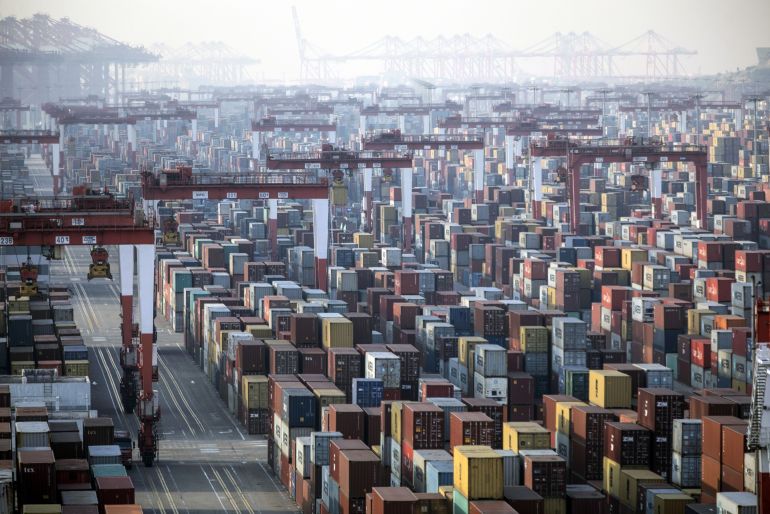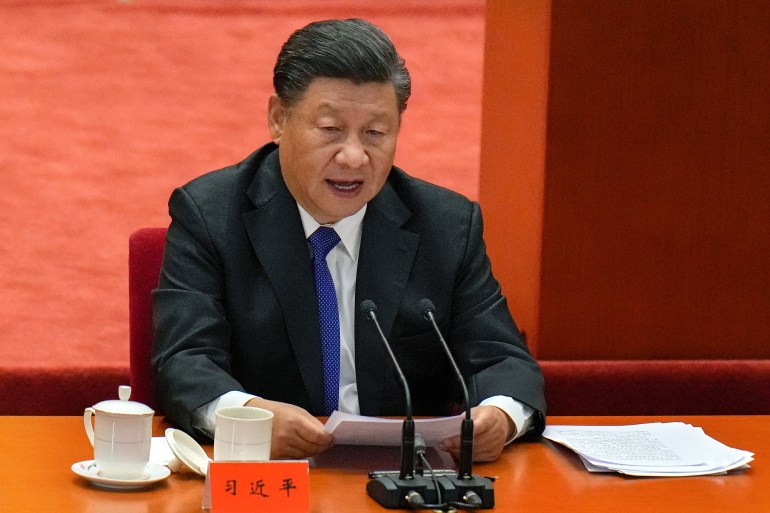
[ad_1]
When Chinese Premier Li Keqiang called for a “sense of urgency” about growing economic risks during a meeting with provincial officials earlier this week, it was his third such warning in days.
“We need to be highly vigilant for unexpected changes in the international and domestic situations, and downward economic pressure has further mounted,” China’s No 2 official told a symposium in Jiangxi province on Monday, according to a report in South China Morning Post, less than a week after drawing attention to the “complicated and evolving” global situation and COVID-19 outbreaks at home.
China’s draconian “dynamic zero-COVID” pandemic restrictions and uncertainties including the war in Ukraine on growth, Beijing appears concerned about the prospects for the world’s second-largest.
The uncertain outlook casts doubt on the ruling Chinese Communist Party’s ability to reach its target of 5.5 percent economic growth in 2022, even as state media insisted the ambitious goal remains within reach, adding to mounting risks for the global economy that include war in Europe, soaring energy prices and upcoming interest rate increases in the United States.
And it raises questions about how far policymakers may go – regardless of adverse economic consequences – to meet Beijing’s lofty ambitions.

If COVID-19 cannot be quickly brought under control – which seems unlikely – then either Beijing’s zero-tolerance strategy economy or the growth target will have to go, said Carsten Holz, an expert on the Chinese professor and at the Hong Kong University of Science and Technology (HKUST).
“In the face of lockdowns, the old channel from state-directed credit to state-directed investment or production becomes inoperative,” Holz told Al Jazeera. “A relatively lockdown-free rural sector cannot save the real GDP growth rate: Agriculture’s share of GDP is only eight percent.
“Industry, the largest sector in GDP, cannot, either, as long as there are lockdowns, nor can the travel and hospitality industries,” Holz said.
Among China’s top 100 cities by GDP, all but 13 are under some level of pandemic restrictions, with the intensity of those controls on the rise, according to a recent analysis by global investment research firm Gavekal.
In Shanghai, a strict lockdown has forced manufacturers such as Tesla and fellow carmaker Nio to suspend production and delay shipments at the city’s port, the largest of its kind worldwide, while sparking rare displays of civil unrest among the metropolis’s 26 million residents.
In March, China’s factories saw activity drop at the quickest pace in two years, while vehicle sales fell nearly 12 percent year on year.
‘Life above all’
Despite the mounting costs, Chinese President Xi Jinping, who is bidding to secure an immediate third term at the next party congress in October, has repeatedly ruled out any shift away from dynamic zero-COVID, peopleing this week putting the country should “persist” above all, life above all.”
Facing deteriorating economic prospects, Beijing has flagged accelerating the rollout of pro-growth measures such as tax cuts and rebates and sales of special-purpose bonds (SPBs) to fund infrastructure projects.
On Monday, the China Securities Regulatory Commission announced that it would ask long-term investors and major shareholders to buy up shares to help stabilise the country’s sagging stock market, which in March saw foreign outflows of $11.2bn in bonds and $6.3bn in stocks.
Many analysts expect more sweeping measures, including interest rate cuts and looser lending rules, to follow in the near future.
“Up now, Chinese leaders have been extremely until about stimulus, but if things continue the way they’re going, Beijing may have little choice but to return to the infrastructure stimulus playbook to goose growth,” Joe Mazur, a politics and finance analyst at Trivium China, told Al Jazeera.
Taylor Loeb, a finance and politics analyst also at Trivium China, said economic conditions have reached the point where “support policies are going to have to cast a wider net”.
“That means cuts to banks’ reserve requirement ratios (RRRs), a measure that gives the financial sector more agency in who they lend to,” Loeb told Al Jazeera.
We’re also seeing a quick rollout of the SPBs that typically fund local government infrastructure projects. SPB funds, like RRR cuts, run the risk of ending up in unproductive projects – as happened throughout the 2010s – but that may be a risk central policymakers have to take to juice the economy.”
Holz, the HKUST professor, suggested Beijing could possibly entertain drastic measures to reach its goal, such as doubling the salaries of state and Communist Party employees.
“It would create a budget deficit on the order of, roughly, 20 percent, but that would not become fully apparent until after the 20th National Congress of the Chinese Communist Party,” he said.

Even so, many economists are sceptical that anything in Beijing’s toolkit will be sufficient to avert a significant slowdown in growth.
On Friday, Morgan Stanley slashed its growth forecast for the Chinese economy this year to 4.6 percent, down from 5.1 percent.
“The policy stimulus will not be that effective as long as mobility is restricted on a broad scale,” Tommy Wu, lead economist at Oxford Economics in Hong Kong, told Al Jazeera.
“The government will have to reduce their emphasis on their growth target and be realistic about how the domestic headwinds and a challenging external environment will affect China’s economy through this year.”
If China’s opaque leadership can’t stomach adjusting its economic goals, particularly in a politically sensitive year, it could seek to change the narrative instead.
“Party Secretary Xi Jinping’s likeliest calculation will be that the easiest solution to the conundrum is to blame COVID-19 for not being able to reach the growth target, keep the death rate low with the help of extensive lockdowns, and secure his tenure as party secretary at the 20th party congress. The PRC’s real growth rate in 2022 could be anything, 0 percent or even negative,” Holz said.
“And public discontent with lockdowns reached evidence, he could cite new scientific and let the COVID wave roll as long as he can present himself as the rational, well-meaning leader that deserves another term as party secretary and president.”
[ad_2]
Source link